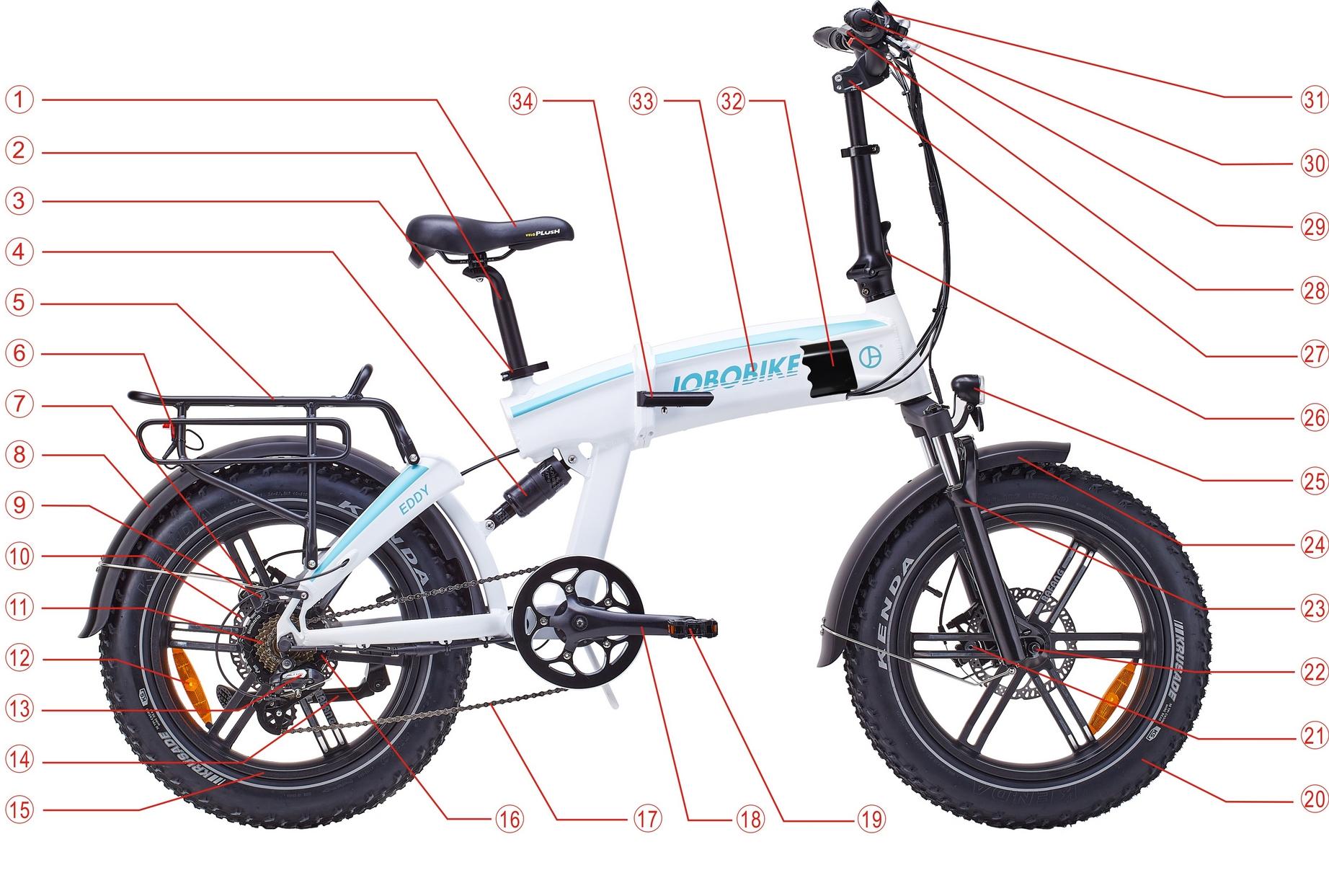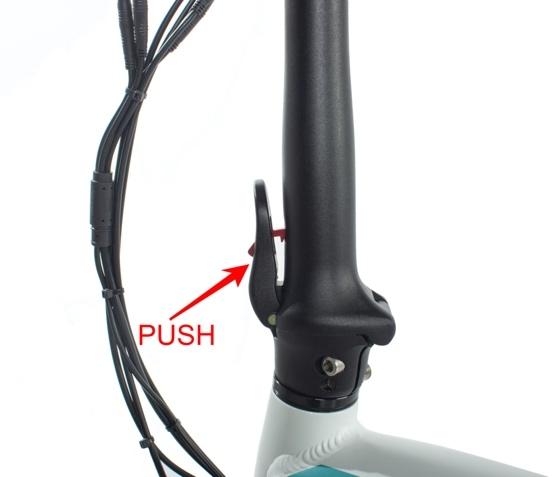
7 minute read
Warnings and Safety
from Eddy manual
by returos
Additional Information on Wear
Components of the E-bike are subject to higher wear when compared to bikes without power assistance. This is because the E-bike can travel at higher average speeds than regular bikes and has a greater weight. Higher wear is not a defect in this product and is not subject to warranty. Typical components affected are the tyres, brake pads and rotors, suspension forks, spokes, wheels, and the battery.
Advertisement
When life of a component has surpassed, it can cause unexpected loss of function, which can result in serious injuries or even death. Therefore, pay attention to indications of wear, such as cracks, scratches, or changes in the color or operation of components, which show that useful life has been exceeded. Worn components should be replaced immediately. If you are unfamiliar with regular maintenance, a certified bike mechanic should be consulted.
General Operating Rules Notice: Pay special attention to all the general operating rules below before operating your bike.
• When riding, obey the laws applicable in your area as any other vehicles. • For additional information regarding traffic/vehicles laws, contact the road traffic authority in your area. • Ride predictably, in a straight line, and with the flow of traffic. Never ride against traffic. • Use correct hand signals to indicate turning. • Ride defensively because to other road users, you may be hard to see.
44
• Concentrate on the path ahead. Avoid potholes, gravel, wet or oily roads, wet leaves, curbs, train tracks, speed bumps, drain gates, thorns, broken glass, and other obstacles, hazards, and puncture flat risks. • Cross train tracks at a 90-degree angle or walk your bike across. • Try to predict the unexpected such as opening car doors or cars backing out of driveways. • Be careful at intersections when preparing to pass other vehicles or other cyclists. •Familiarize yourself with all features and operations of the bike by JOBOBIKE. Practice and become proficient at shifting gears, applying brakes, using power assist system, and using twist power assist in a controlled setting before riding in riskier conditions. •Wear proper riding clothes including closed-toe shoes. If you are wearing loose pants, secure the bottom using leg clips or elastic bands to prevent them from being caught in the chain or other gears. Do not use items that may restrict your hearing. •Check your local rules and regulations before carrying cargo. •When braking, apply the rear brake first, then the front brake. If brakes are not correctly applied, they may lock up, you may lose control and fall. •Maintain a comfortable stopping distance from all other objects, riders, and vehicles. Safe braking distances vary based on factors such as road surface and lighting conditions.
Safety Notes
The following safety notes provide additional information on the safe operation of your bike and should be closely reviewed. Failure to review these notes can lead to serious injury or death.
• All users must read and understand this manual before riding their bike. Additional manuals for individual components should also be reviewed before installing or using those components. • Ensure that you comprehend all instructions and safety notes/warnings.
45
• Ensure that the bike fits you properly before first use. You may lose control or fall if your bike is too big or too small. • Always wear an approved bicycle helmet when riding a bike and ensure that all instructions provided by the helmet manufacturer are used for fit and care of your helmet. Failure to wear a helmet when riding may result in serious injury or death. • Ensure that you have the correct setup with adjusting to the recommended torque values before your first use; check the setup, tightening, and condition of components and hardware regularly. • It is your responsibility to familiarize yourself with the laws and requirements of operating this product in the area(s) where you ride. • Ensure that the handlebar grips are undamaged and properly installed. Loose or damaged grips can cause you to lose control and fall. • Off-road riding requires close attention and specific skills because there are potential conditions that could cause hazards. Wear appropriate safety gear and do not ride alone in remote areas. Check local rules and regulations about whether off-road E-bike riding is allowed. • Do not engage in extreme riding. This includes but is not limited to jumps, stunts, or any behaviors that exceed your capabilities. Although many articles/advertisements/catalogues depict extreme riding as admirable, it is not recommended nor permitted, and you can be seriously injured or killed if you perform extreme riding. Bikes and their components have strength limitations, and extreme riding, including but not limited to jumps, stunts, etc., should not be performed as it can damage your bike’s components and/or cause or lead to dangerous riding situations in which you may be seriously injured or killed. • Failure to perform and confirm proper installation, compatibility, proper operation, or maintenance of any component or accessory can result in serious injury or death. • After any incident, you must consider your bike unsafe to ride until you consult with a certified bike mechanic for a comprehensive inspection for all components, functions, and operations of the bike. • Failure to properly charge, store, or use your battery will void the warranty and may cause a hazardous situation. •You should check the operation of the motor cutoff switches before each ride. The brake system is equipped with an inhibitor that cuts off power to the electric motor whenever the brakes are squeezed. Check proper operation of brake motor cutoff switches before riding. • Extreme care should be taken when using the pedal assistance sensor and twist power assist on this product. Ensure that you are prepared for the power assistance to engage as soon as pedaling is underway.
46
• Users must understand the operation of the twist power assist and pedal assistance sensors before using the bike and must travel at speeds appropriate for certain usage area, riding conditions, and user experience level. Always use the lowest assist level until you are comfortable with the bike and feel confident in controlling the power. • Any aftermarket changes to your bike that are not approved could void the warranty and create an unsafe riding experience. • Because electric bikes are heavier and faster than normal bikes, they require extra caution and care while riding. • Take extra care while riding in wet conditions. You should slow down and increase braking distances. Feet or hands slip more easily in wet conditions and could lead to serious injury or death. • Do not remove any reflectors or the bell. Like any sport, cycling involves risks of damage, injury, and death. By choosing to ride a bike, you take the responsibility for that risk, so you need to practice the rules for safe riding and to perform proper use and maintenance of this bike. Proper use and maintenance of your bike reduces risk of damage, injury, and death. Biking and controlled substances should not mix. Never operate a bike while under the influence of alcohol, drugs, or any substance or condition that could impair motor functions, judgment, or the ability to safely operate a bike or another vehicle. The e-bike is designed for use by persons 18 years old and older. Riders must have the physical condition, reaction time, and mental capability to manage traffic, road conditions, sudden situations, and respect the laws governing electric bike use where they ride, regardless of age. If you have an impairment or disability such as a visual impairment, hearing impairment, physical impairment, cognitive/language impairment, a seizure disorder, or any other physical condition that could impact your ability to safely operate a vehicle, consult your physician before riding any bike. Helmets It is strongly advised that an approved, fitted bicycle safety helmet is always worn during rides.
We recommend riders wear a properly fitted helmet that covers the forehead when riding a bike. Child passengers also should wear a properly fitted helmet.
Wet Weather It is recommended to not ride in wet weather if avoidable. Ride in wet weather only when it is necessary.
47
This electric bike is not meant for use in puddles, heavy rain, or streams. Never immerse or submerge this product in water or any other liquid as the electrical system may be damaged. • In wet weather you need to take extra care when operating this bike. • Decrease riding speed to help you control the bike in slippery conditions. • Brake earlier since it will take brakes longer to slow down than when operated in dry conditions. • Be more visible to others on the road. Wear reflective clothing and use approved safety lights. • Road hazards are more difficult to see when wet; proceed with caution. Night Riding
Night Riding It is recommended to not ride at night. Ride at night only when it is necessary. • Wear reflective and light-colored clothing. • Slow down and take familiar routes with street lighting, if possible. • Ensure that tyre wall, pedal, and other reflectors are properly installed, positioned, clean, and unobstructed. • Use a properly functioning lighting set comprised of a white front lamp and red rear lamp.
A Note for Parents and Guardians As a parent or guardian, you are responsible for the activities and safety of your child. The e-bike is not designed for use by children. If you are carrying a passenger in a child safety seat, they must also be wearing a properly fitted and approved helmet.
48





